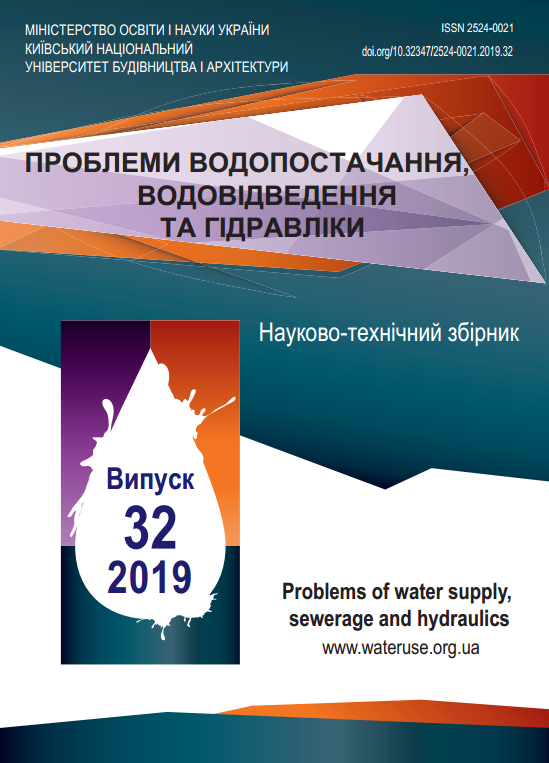Electrocoagulation of water AC 220V
DOI:
https://doi.org/10.32347/2524-0021.2019.32.6-14Ключові слова:
electrocoagulation, bipolar electrodes, alternating current, voltage 220 VАнотація
The process of electrocoagulation has been one of the current areas of research for the last decade. The effectiveness of electrocoagulation is influenced by a number of factors, including the electrical parameters of the process organization: anode current density and operating voltage. The use of direct current is accompanied by the phenomenon of passivation of the electrode block and, as a consequence, with a constant value of voltage - a decrease in the amount of current in the network of the electrocoagulator. The possibility of modernizing the design of the electrocoagulator and changing the organization of the process of electrocoagulation in order to minimize the described difficulties was considered. The work of the electrocoagulator with a series of separated pairs of bipolar electrodes arranged according to the serial scheme is investigated. The electrical parameters of operation of the installation at alternating electric current and with the voltage of the household electricity supply (220 V) were studied. It is shown that the total voltage applied to the electrocoagulator for each individual pair of bipolar electrodes is divided in proportion to the electrical resistance of the water layer between them. For non-flowing water, the system has a certain decrease in the time of the total calculated electrical resistance, which may be due to the heating of the water in the cells from the passage of electric current. The process of formation of an electrolytically generated coagulant at the bipolar location of the electrodes occurs in each individual tank, and that the total mass of the formed coagulant in this scheme, consisting of n vessels, will be equivalent to the expression:mgen = mi × n.Посилання
Mickley, M. (2004). Pretreatment Capabilities and Benefits of Electrocoagulation. Defense technical information center. doi:10.21236/ada433998
Hakizimana, J. N., Gourich, B., Chafi , M., Stiriba, Y., Vial, C., Drogui, P., & Na-ja, J. (2017). Electrocoagulation process in water treatment: A review of electrocoagulation modeling approaches. Desalination, 404, 1-21. doi:10.1016/j.desal.2016.10.011
Vijayakumar, V., Keerthi, & Balasubramanian, N. (2015). Heavy metal Removal by Electrocoagulation Integrated Membrane Bioreactor. CLEAN - Soil, Air, Water, 43(4), 532-537. doi:10.1002/clen.201300555
Butler, E., Hung, Y-T., Yeh, R. Y-L., & Al Ahmad, M. S. (2011). Electrocoagulation in Wastewater Treatment. Water, 3(2), 495-525. doi:10.3390/w3020495
Bellebia, S., Kacha, Z., Bouberka, A., Bouyakoub, Z., & Derriche, Z. (2009). Color Removal from Acid and Reactive Dye Solutions by Electrocoagulation and Electrocoagulation / Adsorption Processes. Water Environment Research, 81(4), 382-393. doi:10.2175/106143008X357200
Mosin, O. V. (2014). Tekhnologicheskiy raschet ustanovok elektrokoagulyatsii vody. Plumbing, Heating, Air Conditioning (SOK), 4, Retrieved from https://www.c-o-k.ru/articles/tehnologicheskiy-raschet-ustanovok-elektrokoagulyacii-vody
Saprykina, M. N. (2012). Novaya razrabotka apparata elektrokoagulyatsionnoy ochistki vody ot mikromitsetov. Khimiya i tekhnologiya vody, 34(5), 407-417. [in Russian]
Karatayev, O. R., Shemsutdinova, Z. R., & Khafizov, I. I. (2015). Ochistka stochnykh vod elektrokhimicheskimi metodami. Vestnik Kazanskogo tekhnologicheskogo universiteta, 18 (22), 21-23. [in Russian]
Khandegar, V., & Saroh, Anil K. (2014). Treatment of Distillery Spentwash by Electrocoagulation. Journal of Clean Energy Technologies, 2 (3), 244-247. doi:10.7763/JOCET.2014.V2.133
Tezcan, Un U., Oduncu, E. (2014). Electrocoagulation of Landfill Leachate with Monopolar Aluminum Electrodes. Journal of Clean Energy Technologies, 2 (1), 15-17. doi:10.7763/JOCET.2014.V2.82
Elektrokoagulyator. (2019). Ochistka stochnykh vod metodom elektrokoagulyatsii // GK TransEkoProyekt. Retrieved from http://enviropark.ru/course/info.php?id=68
Yakovlev, S. V., Krasnoborod'ko, I. G., & Rogov V. M. (1987). Tekhnologiya elektrokhimicheskoy ochistki vody. Leningrad: Stroyizdat. [in Russian]
Melʹnyk, E. S., & Plyashchuk, L. D. (2009). Optymyzatsyya protsessov élektro-koahulyatsyy stochnykh vod halʹvanycheskoho proyzvodsta. Visnyk SumDu. Seriya. Tekhnichni nauky, 1, 200-204. [in Russian]
Antropov, L. I. (1993). Teoretychna elektrokhimiya. Kyiv: Lybíd. [in Ukrainian]
##submission.downloads##
Опубліковано
Як цитувати
Номер
Розділ
Ліцензія
Автори, які публікуються у цьому журналі, погоджуються з наступними умовами:
a) Автори залишають за собою право на авторство своєї роботи та передають журналу право першої публікації цієї роботи, яка через 70 років після смерті останнього співавтора з дати публікації автоматично стає доступною на умовах ліцензії Creative Commons Attribution License, котра дозволяє іншим особам вільно розповсюджувати опубліковану роботу з обов'язковим посиланням на авторів оригінальної роботи та першу публікацію роботи у цьому журналі.
b) Автори мають право укладати самостійні додаткові угоди щодо неексклюзивного розповсюдження роботи у тому вигляді, в якому вона була опублікована цим журналом (наприклад, розміщувати роботу в електронному сховищі установи або публікувати у складі монографії), за умови збереження посилання на першу публікацію роботи у цьому журналі.
c) Політика журналу дозволяє і заохочує розміщення авторами в мережі Інтернет (наприклад, у сховищах установ або на особистих веб-сайтах) рукопису роботи, як до подання цього рукопису до редакції, так і під час його редакційного опрацювання, оскільки це сприяє виникненню продуктивної наукової дискусії та позитивно позначається на оперативності та динаміці цитування опублікованої роботи (див. The Effect of Open Access).


